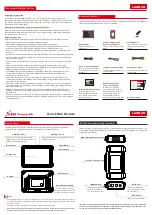
5
LI0105 – 11 December 2013
TENT
A
TIVE 10 Decemb
er
Performance
An important benefit of the small volume and the ¼” microphone is the fact that the resonance
frequency at 30 kHz is so high that it does not interfere with measurements in the audible
frequency range. Therefore it can be used for measurements up to 16 kHz, one octave higher
than achievable with the reference 2cc coupler.
Because of the small volume, the measured sound level from the coupler is about 13.5 dB higher
than with the 2cc coupler. This effect raises the measured signal with respect to the noise floor
and thus improves the signal-to-noise ratio. This difference of signal levels is shown in Fig. 1.
Therefore, the signal-to-noise ratio obtainable with the 0.4cc coupler and a ¼” microphone with a
sensitivity of about 1.5mV/Pa is almost as good as that of a 2cc coupler using a ½” microphone
with a sensitivity of 12.5mV/Pa. The 43BA-1 has a sensitivity of 1.5 mV/Pa and the noise floor
is 39dB(A), the 43BA-2 has a sensitivity of 1.45 mV and the noise floor 44dB(A).
When used with a high-sensitivity microphone (18 mV/Pa), the 0.4cc is very close to the 2cc
coupler in this respect. With the 43BA-3 high sensitivity version, the noise floor is 25dB(A).
Refer to page 13 for more information about the 43BA’s specifications.
0,0
10,0
20,0
30,0
40,0
50,0
60,0
70,0
80,0
90,0
100
1000
10000
M
ag
n
it
u
d
e
[d
B
r
e
2
0
u
P
a]
Frequency [Hz]
Typical Frequency Response
With G.R.A.S. 1/4" pressure microphone as receiver @ 1Vrms input signal
0.4cc coupler response
2cc coupler response
Fig. 1.
0.4cc coupler compared to the reference 2cc coupler, with a ¼” microphone used as receiver.
































